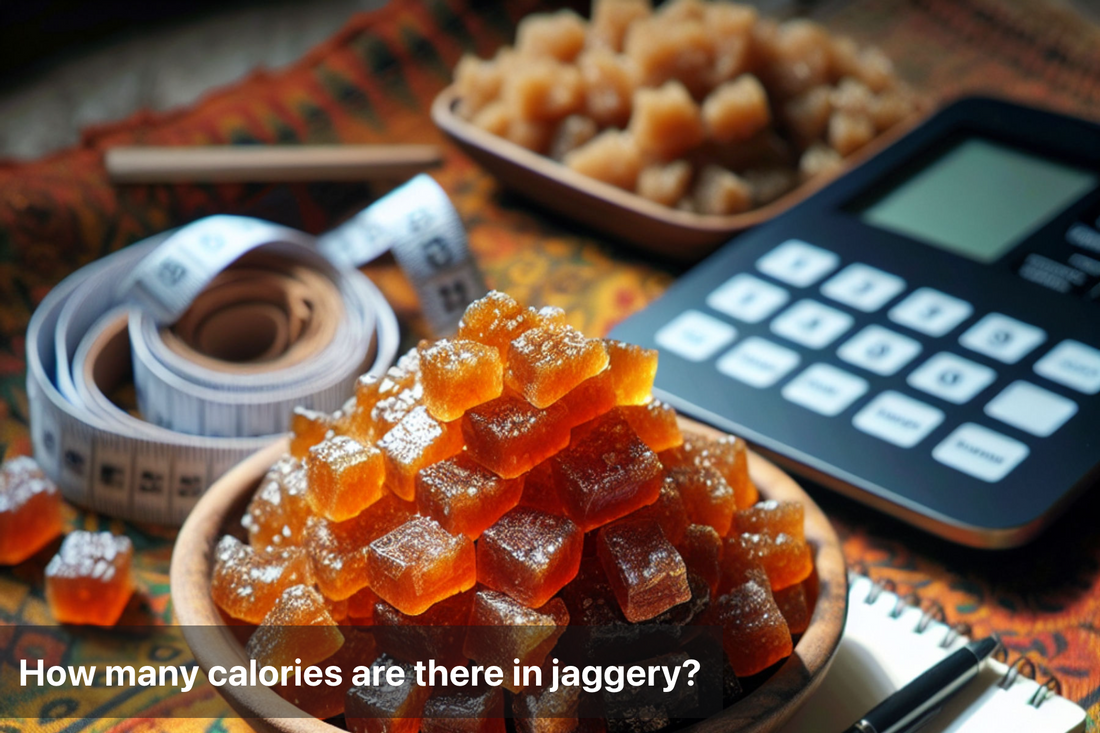
How many calories are there in jaggery?
Share
Jaggery—known as gur in Hindi—is a traditional Indian sweetener made by boiling raw sugarcane juice or palm sap until it solidifies. Used for centuries in Indian kitchens, jaggery isn't just a dessert ingredient; it's also a digestive aid, an energy booster, and a cold remedy. But how does jaggery stack up in terms of calories? And is it really healthier than sugar? Let’s take a detailed look at the calorie content in jaggery and how it fits into a balanced diet.
Calories in Jaggery
Jaggery is an unrefined form of sugar, and while it's rich in minerals, it still contains a significant amount of natural sugars. On average:
Quantity of Jaggery |
Calories (Approx) |
|---|---|
1 teaspoon (5g) |
~19 kcal |
1 tablespoon (15g) |
~57 kcal |
50g piece (medium) |
~190 kcal |
100g jaggery block |
~380 kcal |
The caloric value may vary slightly depending on whether the jaggery is made from sugarcane or palm, and how much moisture it retains.
Macronutrient Breakdown (Per 100g Jaggery)
Nutrient |
Value |
|---|---|
Calories |
~380 kcal |
Carbohydrates |
~98 g |
Sugars |
~95 g |
Protein |
~0.4 g |
Fat |
~0.1 g |
Fiber |
~0.6 g |
Iron |
~11 mg |
Magnesium |
~70 mg |
Potassium |
~1050 mg |
Jaggery is almost entirely carbohydrate, primarily from sucrose, but with trace amounts of iron, magnesium, and potassium—making it nutritionally richer than white sugar.
Is Jaggery Healthier Than Sugar?
While jaggery and white sugar provide similar calories, jaggery is considered a better choice due to the presence of trace minerals and antioxidants. Here’s how they compare:
Criteria |
Jaggery |
White Sugar |
|---|---|---|
Calories (per 100g) |
~380 kcal |
~400 kcal |
Nutrients |
Iron, potassium, magnesium |
None |
Processing |
Unrefined |
Heavily refined |
Taste Profile |
Deep, caramel-like |
Purely sweet |
However, moderation is key. Despite its health halo, jaggery still spikes blood sugar and can lead to weight gain if overconsumed.
Health Benefits of Jaggery (When Consumed in Moderation)
1. Natural Detoxifier
Jaggery is traditionally used to cleanse the lungs and respiratory tract. It is especially recommended during winter or after exposure to dust and pollution to flush out toxins.
2. Rich in Iron
One of the standout nutrients in jaggery is iron, which supports red blood cell production and combats anemia. This makes it beneficial for menstruating women, children, and anyone with low hemoglobin.
3. Boosts Digestion
Jaggery activates digestive enzymes and helps ease constipation by stimulating bowel movements. That’s why many people eat a small piece of jaggery after meals in Indian households.
4. Provides Quick Energy
Due to its high carbohydrate content, jaggery provides an instant energy boost. It releases energy slowly compared to white sugar, making it a good pre-workout snack or quick energy source during fatigue.
5. Eases Menstrual Discomfort
Traditionally, jaggery is consumed with sesame seeds or ginger to help reduce menstrual cramps and mood swings by improving blood circulation and releasing endorphins.
How Much Jaggery Can You Eat Daily?
Even though jaggery is healthier than refined sugar, it’s still a sweetener and should be eaten in limited quantities.
Recommended daily intake: 1 to 2 teaspoons (5–10g), especially for healthy individuals
People with diabetes, insulin resistance, or PCOS should avoid or strictly limit jaggery intake due to its high glycemic load
Always account for jaggery calories in your total daily caloric budget if you're aiming for weight loss or fat loss
Smart Ways to Include Jaggery in Your Diet
Mix 1 tsp jaggery in warm water with lemon as a morning detox drink
Replace sugar with jaggery in tea, buttermilk, or herbal kadha
Use powdered jaggery in sweet dishes like kheer, pongal, or sukhdi
Combine with roasted peanuts and sesame for nutrient-rich energy bites
Add grated jaggery to chapati dough or porridge for a natural sweetness
Types of Jaggery and Their Calorie Differences
1. Sugarcane Jaggery
The most common form in India, available in blocks or powders. Moderate in calories (~380 kcal/100g) and rich in iron and calcium.
2. Palm Jaggery (Karupatti)
Made from palm sap, this variant is darker, richer in minerals, and has a lower glycemic index. Slightly less sweet than sugarcane jaggery.
3. Date Palm Jaggery
Popular in Bengal and Bangladesh, it has a unique taste and is more aromatic. Calorie content is similar but often considered more medicinal.
4. Liquid Jaggery (Kakvi)
Used in Maharashtra and Karnataka, it’s a syrupy form ideal for drizzling on rotis or pancakes. Its moisture content makes it less calorie-dense per spoon.
When to Avoid Jaggery
If you’re diabetic, consult your doctor before including jaggery—it may spike blood sugar as much as refined sugar
People with gut issues like IBS should avoid large quantities of jaggery as it can ferment in the gut and cause gas
Avoid giving jaggery to infants under 1 year as their digestive system is not developed enough for complex sugars
If you're on a low-carb or ketogenic diet, jaggery is not allowed due to its high sugar content
Summary
Jaggery contains approximately 380 calories per 100 grams, making it energy-dense and similar to sugar in caloric content. However, what sets it apart is its rich mineral profile, digestive benefits, and traditional medicinal value. When consumed in small amounts, jaggery can be a healthier alternative to refined sugar—offering not just sweetness but also trace nutrients like iron, potassium, and magnesium. The key lies in mindful moderation. Whether you enjoy it in your tea, in a ladoo, or post-meal as a palate cleanser, jaggery can be a wholesome, natural way to sweeten your diet—if used wisely.






